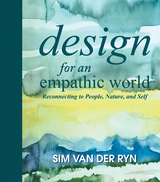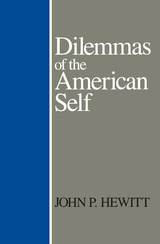122 books about Self and 3
start with D
122 books about Self and 3
122 books about Self
3 start with D start with D
3 start with D start with D

Design for an Empathic World
Reconnecting People, Nature, and Self
Sim Van der Ryn
Island Press, 2014
Despite an uncertain economy, the market for green building is exploding. The US green building market has expanded dramatically since 2008 and is projected to double in size by 2015 (from $42 billion in construction starts to $135 billion). But green-building pioneer Sim Van der Ryn says, “greening” our buildings is not enough. He advocates for “empathic design”, in which a designer not only works in concert with nature, but with an understanding of and empathy for the end user and for ones self. It is not just one of these connections, but all three that are necessary to design for a future that is more humane, equitable, and resilient.
Sim’s lifelong focus has been in shifting the paradigm in architecture and design. Instead of thinking about design primarily in relation to the infrastructure we live in and with—everything from buildings to wireless routing—he advocates for a focus on the people who use and are affected by this infrastructure. Basic design must include a real understanding of human ecology or end-user preferences. Understanding ones motivations and spirituality, Sim believes, is critical to designing with empathy for natural and human communities.
In Design for an Empathic World Van der Ryn shares his thoughts and experience about the design of our world today. With a focus on the strengths and weaknesses in our approach to the design of our communities, regions, and buildings he looks at promising trends and projects that demonstrate how we can help create a better world for others and ourselves. Architects, urban designers, and students of architecture will all enjoy this beautifully illustrated book drawing on a rich and revered career of a noted leader in their field. The journey described in Design for an Empathic World will help to inspire change and foster the collaboration and thoughtfulness necessary to achieve a more empathic future.
Sim’s lifelong focus has been in shifting the paradigm in architecture and design. Instead of thinking about design primarily in relation to the infrastructure we live in and with—everything from buildings to wireless routing—he advocates for a focus on the people who use and are affected by this infrastructure. Basic design must include a real understanding of human ecology or end-user preferences. Understanding ones motivations and spirituality, Sim believes, is critical to designing with empathy for natural and human communities.
In Design for an Empathic World Van der Ryn shares his thoughts and experience about the design of our world today. With a focus on the strengths and weaknesses in our approach to the design of our communities, regions, and buildings he looks at promising trends and projects that demonstrate how we can help create a better world for others and ourselves. Architects, urban designers, and students of architecture will all enjoy this beautifully illustrated book drawing on a rich and revered career of a noted leader in their field. The journey described in Design for an Empathic World will help to inspire change and foster the collaboration and thoughtfulness necessary to achieve a more empathic future.
[more]

Dilemmas Of American Self
John P. Hewitt
Temple University Press, 1991
Charles Horton Cooley Award of the Society for the Study of Symbolic Interaction, 1990
"According to Hewitt, the essence of modernity is tension between community and society. This ambitious, sophisticated, and well-written book is a tonic for those who weary of simplistic sermons on the condition of American culture."
--Choice
This book explores stability and change in American social character and identity, and offers a theory about what it means to be an individual within contemporary American society. Skeptical of the widely-accepted thesis that the self, at least in America, has drastically changed, John P. Hewitt assumes that there is more historical continuity and that the culture is filled with internal contradictions. Combining the insights of social psychology, with those of writers who have offered critiques of the larger society and its influences on the individual, he revises our understanding of the person in American society.
Hewitt examines the theories of such authors as David Riesman, Allen Wheelis, Christopher Lasch, Erving Goffman, Carl Rogers, Ralph Turner, and others. He treats their emphasis on the decline of transformation of the self not as social theory to be tested, but as cultural text that reveals some of the main historical and contemporary features and fault lines of American culture.
"American culture is best characterized not as relentlessly individualistic or as lacking in the capacity to conceive of or discuss community, but as torn between individualism and communitarianism, thus creating serious felt difficulties of social adjustment and personal meaning." Proposing a symbolic interactionist theory of culture, Hewitt emphasizes inherent polarities of meaning and dilemmas of conduct that shape the experience of self: conformity versus rebellion, staying versus leaving, and dependence versus independence. He constructs a theory of identity that views personal identity and social identity as contending means for securing the continuity and integration of the self, and applies the theory to American society by depicting autonomous, exclusivist, and pragmatic strategies of self-construction.
"This theoretically sophisticated work is very ably organized and marked by superior scholarly and expository craftsmanship. It will be hailed, I believe, as an important contribution to symbolic interactionism and the sociology and social psychology of everyday life. Hewitt's treatment of self, identity, conformity, differentiation, community, and modernity is a fine example of creative scholarship."
--Charles H. Page, University of Massachusetts (Emeritus)
"Hewitt has set himself the ambitious task of providing a symbolic interactionist analysis of culture, society, and self, and has succeeded admirably in the effort. I found his rich description of cultural types to be especially insightful. It is no exaggeration to characterize this book as a landmark work in the development of symbolic interactions."
--Morris Rosenberg, University of Maryland-College Park
[more]

Dostoevsky and the Riddle of the Self
Yuri Corrigan
Northwestern University Press, 2017
Dostoevsky was hostile to the notion of individual autonomy, and yet, throughout his life and work, he vigorously advocated the freedom and inviolability of the self. This ambivalence has animated his diverse and often self-contradictory legacy: as precursor of psychoanalysis, forefather of existentialism, postmodernist avant la lettre, religious traditionalist, and Romantic mystic.
Dostoevsky and the Riddle of the Self charts a unifying path through Dostoevsky's artistic journey to solve the “mystery” of the human being. Starting from the unusual forms of intimacy shown by characters seeking to lose themselves within larger collective selves, Yuri Corrigan approaches the fictional works as a continuous experimental canvas on which Dostoevsky explored the problem of selfhood through recurring symbolic and narrative paradigms. Presenting new readings of such works as The Idiot, Demons, and The Brothers Karamazov, Corrigan tells the story of Dostoevsky’s career-long journey to overcome the pathology of collectivism by discovering a passage into the wounded, embattled, forbidding, revelatory landscape of the psyche.
Corrigan’s argument offers a fundamental shift in theories about Dostoevsky's work and will be of great interest to scholars of Russian literature, as well as to readers interested in the prehistory of psychoanalysis and trauma studies and in theories of selfhood and their cultural sources.
Dostoevsky and the Riddle of the Self charts a unifying path through Dostoevsky's artistic journey to solve the “mystery” of the human being. Starting from the unusual forms of intimacy shown by characters seeking to lose themselves within larger collective selves, Yuri Corrigan approaches the fictional works as a continuous experimental canvas on which Dostoevsky explored the problem of selfhood through recurring symbolic and narrative paradigms. Presenting new readings of such works as The Idiot, Demons, and The Brothers Karamazov, Corrigan tells the story of Dostoevsky’s career-long journey to overcome the pathology of collectivism by discovering a passage into the wounded, embattled, forbidding, revelatory landscape of the psyche.
Corrigan’s argument offers a fundamental shift in theories about Dostoevsky's work and will be of great interest to scholars of Russian literature, as well as to readers interested in the prehistory of psychoanalysis and trauma studies and in theories of selfhood and their cultural sources.
[more]
READERS
Browse our collection.
PUBLISHERS
See BiblioVault's publisher services.
STUDENT SERVICES
Files for college accessibility offices.
UChicago Accessibility Resources
home | accessibility | search | about | contact us
BiblioVault ® 2001 - 2024
The University of Chicago Press









